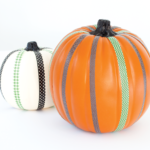Surprisingly, not all spider species spin webs. But those that do make such beautiful ones. You think it’s easy to whip up a fly trap out of silk? Try your hand at creating a web the way real spiders do. This won’t be any old tiny web either. This web is made for a spider the size of a soccer ball! (If you just want to make an itty bitty web, you can just choose proportionately smaller amounts of materials.)

What You’ll Need:
- 3 different colors of yarn or string. One should be 20 feet (6 m) long, the others each about 10 feet (3 m) long.
- A large Y-shaped stick. Ours made a triangle that was about 3 feet on each side. If you don’t live near trees, you can purchase 2 dowels and lash them together to form a V shape with some string or pipe cleaners.
- A glue stick
- A piece of newspaper or other surface that is safe for gluing
What to Do:
- Pick up your longest piece of yarn. You’ll use pieces of this in the next 5 steps. Tie one end to a high point on the left side of your Y stick.
- Pretend you are a spider and release the free end from your spinnerets into the wind. What? You can’t shoot strands of silk from your butt? Too bad. You’ll have to use your hands to string the yarn across to the other side of the Y and tie another knot. Cut the excess string off. A spider would release a thread into the wind and wait for it to catch something—a nearby tree, perhaps—and then they would pull it tight and secure it to whatever they’re standing on. This is called a bridge line.
- Loosely tie another thread of the same color across the Y so that it hangs down below the tight bridge thread. Cut the end off.
- Tie another piece of yarn to the center of the loosely hanging thread. This new piece should hang vertically. Secure this piece at the bottom of the Y stick, and cut.
- Create a V shape by tying two new pieces of yarn between the bottom of the Y stick and the two knots on each end of the bridge line.
- A spider would now fill in the gaps with threads that go from the outer edges to the middle. These are called “radius threads.” You can make some too. We used eight, but a spider would use as many as necessary for easy travel across the web. Trim all the ends sticking out from the knots.
- Now for the spiral. First, a spider makes a nonsticky spiral that she can walk on. (Otherwise she’d get stuck in her own web! Yikes!) Pick a different color yarn and tie it to the center of the web. Then twist it outwards into a spiral. Every time you cross a radius thread, put a dab of glue there to secure it. Keep spiraling until you reach the edge of the web. A spider uses its legs to keep the measurements even.
- Next, a spider would turn around and create a sticky spiral back along the path of the original nonsticky spiral. Take your third color of yarn and rub the glue stick all over it. Get it really sticky!
- Follow the path of your nonsticky spiral, placing your sticky spider silk just around it and pressing it into the web structure so that both spirals will stay.
- Hang your spiderweb in your room and pretend you live on it! Maybe you’ll get lucky and catch some yummy flies! Dinner! In fact, before the glue dries, you can play a game called “Spider Suppertime.” Use small cotton balls to represent flies (you can color them black with a magic marker). Can you catch a fly? Bon appétit!
Excerpted from Joy Masoff’s Oh, Ick! (Workman).





No Comments